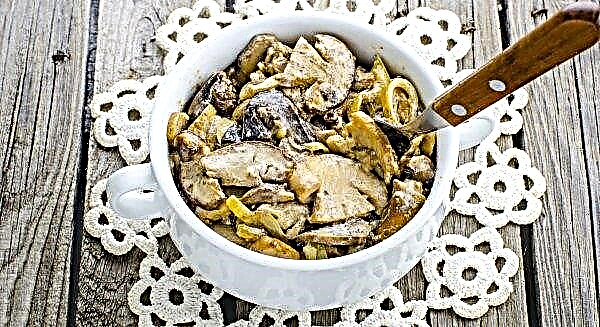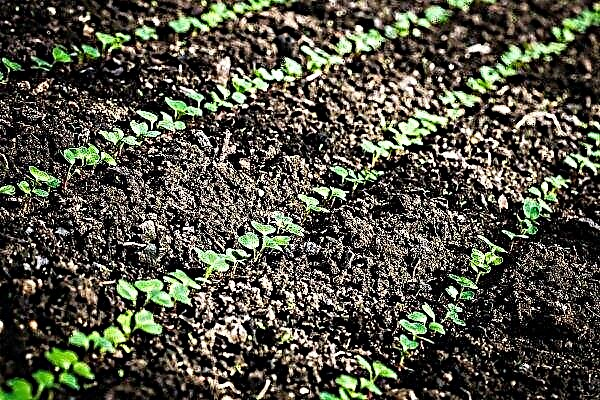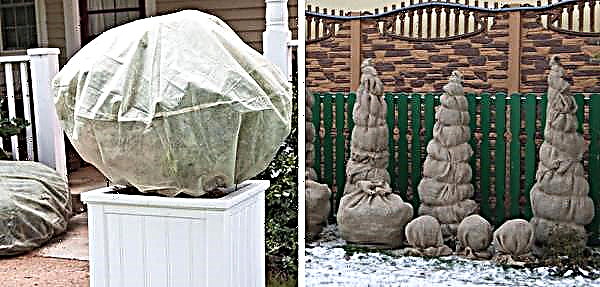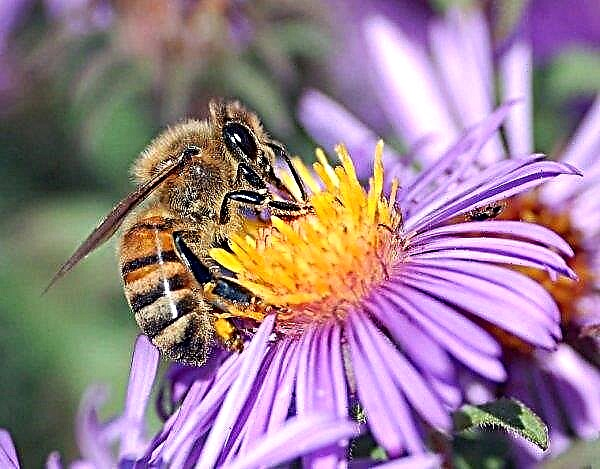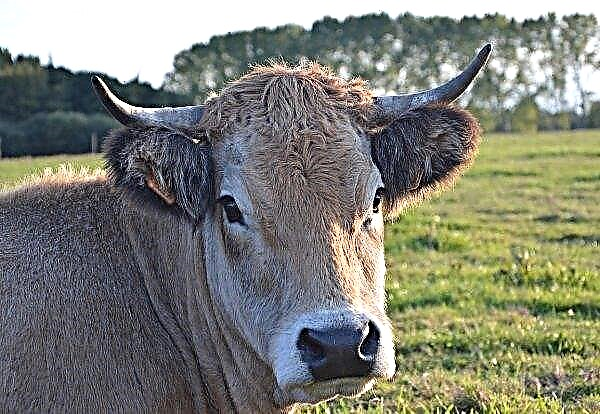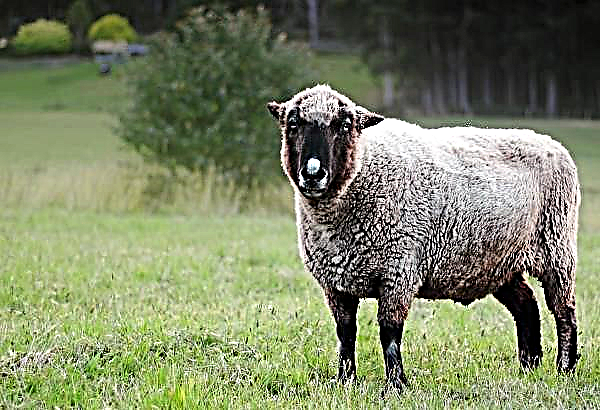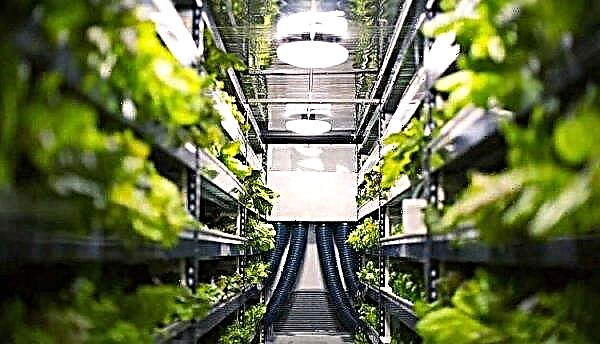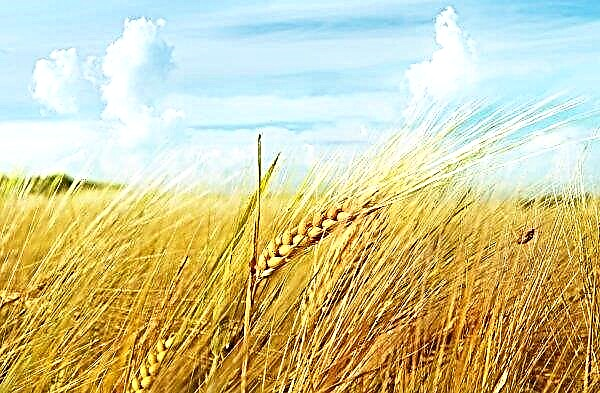To grow a high-yielding, tasty and healthy sweet pepper, you need to know how to plant it correctly and how to care for it. You will learn about the nuances of growing Red Bull from this material.
Description and characteristics of the variety
Bushes near the red bull pepper are strong, tall - up to 150 cm in height. The leaves are medium in size, dark green in color, characterized by weak wrinkling. The plant is suitable for cultivation in open and protected ground. Well resists characteristic nightshade diseases.
Did you know? Peppers can be colored in green, red, orange, yellow. The differences are not only in color, but also in the composition of the fruits. Red pepper contains the largest amount of vitamin C, almost like citrus fruits.
Yield Feature
Red Bull pepper ripens in the early stages. From planting to ripe fruit, 95-105 days pass. The variety is classified as high-yielding. From 1 m², you can remove 7–9 kg of fruit. On one plant, 6 to 8 peppers are tied.
Fruit Description
The fruits of the Red Bull are large with thick walls. The weight of one pepper is 250–300 g, the diameter is 9 cm, the length is up to 20 cm. There are also 400 g of specimens.

Peppers are cuboid in shape. The skin color with technical ripeness is dark green, with biological ripening - bright red. The fruits of the Red Bull are delicious and juicy. Well stored and do not lose their presentation after transportation.
Advantages and disadvantages of the variety
- Red Bull pepper has the following advantages:
- seeds have a high percentage of germination - 92%;
- fruit setting occurs even in low light;
- fruits ripen in the early stages;
- large, tasty peppers form;
- yield stably high;
- the plant is resistant to pepper diseases and harmful insects;
- long fruiting period;
- fruits can be used for various culinary purposes;
- peppers are stored for a long time, they perfectly tolerate transportation.
- The disadvantages include:
- sensitivity to soil acidity;
- the need for mandatory garter and stepsoning;
- the inability to collect their own seeds, as this is a hybrid.
Features of agricultural technology
Before you start planting pepper, you need to choose a good site, healthy and high-quality planting material, grow strong seedlings.
Seed treatment
So that seedlings grow healthy, with a good immune system and quickly grow, seed material should be prepared, which involves:
- dressing;
- keeping in nutrient solution;
- germination;
- hardening.
To begin with, the seeds are incubated for 20-30 minutes in a solution of potassium permanganate. Such treatment is necessary to exclude the development of certain diseases. After pickling, the seed is washed under running water and placed in a nutrient solution to improve germination.

There are several options for feeding seed:
- Dissolve nitrophosk (1 tsp) in 1 l of water and soak the seed for a day.
- Mix wood ash (1 tsp) with 1 l of water. To sustain seeds during the day.
- Place the planting material in a liquid solution of sodium humate, heated to a temperature of + 25 ... + 28 ° C. The duration of the procedure is one day.
- Soak in a warm preparation "Ideal" (+ 25 ... + 28 ° C) for a day.
- Mix the product "Azotofit" (5-10 ml) with 0.5 l of water. Duration of soaking - 2 hours.
Germination is as follows:
- At the bottom of a flat tank lay fabric.
- Moisturize it and moisten with an aqueous solution of wood ash (1 tbsp. L / 1 l).
- Seeds are poured onto wet tissue.
- Cover the container with film or glass.
- They put it in a room with a temperature of + 25 ... + 30 ° С.
- As necessary, the seeds are moistened with a spray bottle.
The first sprouts should appear after 7-14 days. Another important procedure for growing seedlings is seed hardening. To do this, they are first placed on the lower shelf of the refrigerator for 48 hours, and then transferred to a temperature of + 18 ° C for 24 hours. Then the seed is again placed in the refrigerator. After 2 days they are sown in the ground.Important! It is advisable to sow pepper seeds immediately in separate containers, since when growing in a common tray, picking is required, and this can lead to damage to the fragile roots of the plant and growth retardation.
The selection of containers for seedlings
Tanks for planting seedlings can be selected different - special, purchased in the store (peat glasses, cassettes), or those that were found at hand (boxes, trays). Ordinary plastic glasses will do.
Soil preparation
Soil for growing seedlings also requires preparation and processing. It is worth choosing a light and loose soil, through which nutrients can quickly enter the root system. Soil can be bought at a specialty store. On the package should be indicated: "For seedlings."

You can also do it yourself by mixing these components:
- humus (2 parts) with turfy earth (1 part);
- peat with humus (in a ratio of 1 to 1);
- nutritious peat mixture (2 parts) with soddy soil (1 part);
- peat (4 parts) with soddy soil (2 parts), humus (1 part), rotted sawdust (1 part).
Soil mixed from different components must be decontaminated.
Etching of the soil is carried out by several methods:
- Watered with a dark pink solution of potassium permanganate.
- Pour boiling water over.
- It is kept in the oven at a temperature of +80 ... + 90 ° С for 20–40 minutes.
- They put on a steam bath for 40 minutes.
- Put in the microwave for maximum mode for 10 minutes.
Sowing seeds
Pepper seeds are sown in late February - early March. If one large tank is selected for sowing, then furrows are made in it and seeds are placed to a depth of 1-1.5 cm.  A distance of 3-4 cm is left between the furrows. In separate containers, 2 holes are made with a depth of 1-1.5 cm and 1 seed is placed in them. Seeds sprinkled with soil. The containers are covered with a film or glass, then placed in a warm room.
A distance of 3-4 cm is left between the furrows. In separate containers, 2 holes are made with a depth of 1-1.5 cm and 1 seed is placed in them. Seeds sprinkled with soil. The containers are covered with a film or glass, then placed in a warm room.
Seedling Care Technique
Caring for seedlings involves watering it, picking it (when grown in one container), top dressing, hardening. Shelters are removed from seedlings when the first sprouts appear. After this, seedlings should be spent the first week at a temperature of + 13 ... + 16 ° С in the daytime and + 8 ... + 10 ° С in the night. Then they should again be returned to warm conditions with a temperature regime of + 20 ... + 27 ° C.
Humidify seedlings is recommended once a week. Watering should be plentiful. It is important to ensure that the drops do not fall on the stems and leaves. When grown in one box, picking is performed when 2–4 leaves appear. Seedlings are planted in separate containers with a volume of 0.3-0.5 liters.Important! During the hardening procedure, it is necessary to shade the sprouts from sunlight.
The first top dressing is done 14 days after the dive. A mixture of superphosphate (50 g) with urea (5 g) and water (10 L) is added. The second top dressing is carried out 3-4 days before the sprouts move to a constant place of growth. During it, a mixture of superphosphate (50 g) with potassium sulfate (25 g) diluted in a bucket of water is added. Ready-made fertilizers are also suitable, for example: Agricola, Mortar, Fortress.
The hardening procedure begins 10-15 days before the planned date of planting in open ground or a greenhouse. First, the sprouts are kept with an open window, then they are taken out to fresh air, starting from 40 minutes a day. Gradually increase the time to 6-8 hours. Immediately before landing, they are left to spend the night on the street.
Planting seedlings in the soil
If the sowing of seeds was carried out in the recommended period, then the sprouts are planted in the greenhouse at the end of April, in unheated shelter in May, and on garden beds in early June.
Landing is carried out when the temperature + 15 ... + 17 ° С is established on the street. At this time, the sprouts should reach the age of 65–70 days. Their stems should be strong, not less than 20-30 cm high. 6-8 leaves should grow on each of them.
Important! Successful growth, development and yield of pepper are possible subject to the rules of crop rotation. A vegetable plant should not be planted after potatoes, peppers, tomatoes, eggplants. The best predecessors are pumpkin, cabbage, and legumes.
Red bull pepper is planted according to the scheme of 35 × 50 cm. A well-lit, sheltered from the winds section is assigned to the culture. On 1 m² should be placed no more than 4 plants. Since acidic soil is not suitable for plants of this variety, dolomite flour or lime must be added to the site before planting.
Wells are prepared in soil prepared from autumn or fertilized in spring. Their depth should be such that the root neck of the sprout when planting is at soil level. In each hole contribute 1 tbsp. complex mineral fertilizer.
Sprouts are moved to the holes without destroying the earthen coma. After the hole is half filled with soil, it is watered using 3–3.5 liters of water per hole. After absorbing water, the earth is poured to the top.
 After planting, the soil in the near-stem circle and row spacing is mulched. If it is predicted that the thermometer is expected to drop below + 13 ... + 14 ° C, young plants are harbored. The first 2–3 days after planting will also require shelter from aggressive sunlight.
After planting, the soil in the near-stem circle and row spacing is mulched. If it is predicted that the thermometer is expected to drop below + 13 ... + 14 ° C, young plants are harbored. The first 2–3 days after planting will also require shelter from aggressive sunlight.
Care after planting in the ground
Pepper care is not easy. Time should be allocated for regular watering, top dressing, hilling, pinching, soil care, tying.
Watering
Peppers need frequent, but not plentiful moisturizing. Recommended frequency - 1 time per week. The best way to water is drip. Water for irrigation is taken only warm. When moistening under the root, it is necessary to ensure that the drops do not fall on the leaves and stems - this can cause burns. Watering is carried out in the early morning or evening, after sunset.
Fertilizer application
Peppers can be fed in several ways:
- Apply green fertilizer every 2 weeks before fruiting, and phosphorus and potassium-containing complexes after ovary formation.
- Complex mineral fertilizer with a low nitrogen content (with dosages and frequency, according to the instructions).
- Three times a season with self-made top dressings: 2 weeks after planting the seedlings in the ground with superphosphate (2 tsp / 10 l of water), during flowering of a mixture of superphosphate (4 tsp) diluted in 10 l of water, urea (1 tsp), potassium sulfate (1 tsp), during fruiting period with potassium salt (2 tsp), superphosphate (2 tsp) dissolved in 10 l of water.
Hilling and loosening the soil
There is no unequivocal opinion among experts and gardeners about whether hilling is necessary for pepper. Proponents of the need for this procedure believe that it stimulates the formation of additional roots, improves plant growth and development.

Opponents of hilling argue that it is harmful to pepper, since it increases the risk of root decay. If you consider it appropriate to carry out the hilling of pepper, then it must be done before the formation of cotyledon leaves.
Among the procedures that this vegetable plant undoubtedly needs are loosening, weeding, mulching. Loosening improves the air and moisture conductivity of the soil. In a well-loosened soil, nutrients are delivered to the roots faster and better absorbed. Loosen the soil near the pepper shallow and gently.
As necessary, you need to get rid of weeds, which take away nutrients from the pepper, cover it from the sun and become carriers of pathogens of diseases, as well as harmful insects.
Mulching is done after watering. In the aisles and near-stem zone, a layer of straw, peat, and overripe grass is poured. This procedure helps maintain optimal soil moisture and inhibits weed growth.Did you know? The first documentary source mentioning pepper cultivation was written 3 thousand years ago in Sanskrit.
The formation of pepper bushes
Since the bushes of the Red Bull are tall, they must be tied to supports or trellis and form a bush. After planting in a greenhouse or open ground, it is necessary to break off the side shoots and leaves with the hands of the plants before the first fork.

Pest and Disease Control
Red bull pepper is resistant to most diseases characteristic of the nightshade family. Therefore, there is no need for preventive spraying. However, one should adhere to the recommendations on crop rotation, conduct competent agricultural techniques, use mixed plantings, planting horseradish, calendula, coriander, beans and other strongly smelling plants in the vicinity of pepper, capable of repelling insects, not to thicken the plantings.
One of the common problems gardeners face when growing Red Bull peppers is dropping flowers and ovaries. This is due to overfeeding the soil with nitrogen. It is necessary to ensure that nitrogen is not present in the fertilizer applied at the flowering stage. At this time, plants need only potassium and phosphorus.
Harvesting and crop applications
Peppers that are grown for sale should be harvested at the stage of technical maturity - when the fruits reach the mass and size declared in the varietal characteristics, but will be dark green in color. They must be folded into boxes. In this state, they will turn red and ripen, preserving commercial qualities. Fruit harvesting is carried out gradually, every 5-7 days.

For your own purposes, winter harvesting, fruits can be harvested in a state of biological maturity, which occurs 20-30 days after the technical. At this time, the peppers become as juicy as possible, their skin turns bright red.
Pepper must be cut with scissors or secateurs, leaving the stalk. Tearing them off is not worth it, as you can damage the stem. Pepper is stored for a short time - 1–1.5 months. The longest possible storage period is possible in temperature conditions + 8 ... + 10 ° С, with humidity 80–90%. The fruits need to be wrapped in paper.
Due to its attractive appearance and excellent taste, Red Bull pepper has been widely used in cooking. It can be used to prepare fresh salads, stuffed, cook lecho, add to the first dishes, caviar, canned and frozen for the winter.
Pepper variety The red bull is chosen for planting in suburban areas, primarily because of the large, unusual shape and bright color of the fruit and high productivity. You can get an abundance of delicious and juicy peppers if you adhere to the recommendations for planting and caring for the plant.

